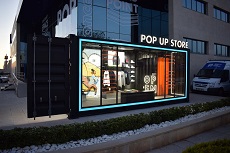
You’ve probably been inside one, maybe even bought something from one: Pop-up stores are becoming increasingly popular in both small and big cities. And they’re also an increasingly popular way to revitalize neighborhoods across the U.S. by bringing new life and energy to vacant retail spaces.
These temporary retail spaces offer a great opportunity for entrepreneurs, artists, and small businesses to showcase their products and services, while also attracting foot traffic and generating buzz in the local community.
We recently asked Lorenzo Bonfiglio, Head of Expansion and Strategy for xNomad, a Swedish marketplace platform that specializes in short-term retail pop-ups, to share some thoughts on how this works.
Filling Vacant Spaces and Generating Income
One of the primary benefits of pop-up stores is their ability to fill vacant retail spaces that would otherwise remain empty and uninviting. By occupying these spaces, even temporarily, pop-up stores can generate rental income for property owners and prevent the negative impact of vacant storefronts on the surrounding area. This not only provides a financial boost but also helps maintain the vibrancy and appeal of the neighborhood.
Pop-up stores can be particularly beneficial in areas that have been hit hard by economic downturns or shifts in consumer behavior. By activating vacant spaces, even for a short period, these temporary businesses can help prevent the spiral of blight and disinvestment that can occur when too many storefronts remain unoccupied.
Testing New Concepts and Markets
Pop-up stores serve as an excellent testing ground for businesses to gauge consumer interest and demand for their products or services in a particular location. This low-risk approach allows entrepreneurs to experiment with new concepts, gather valuable customer feedback, and make informed decisions about potential long-term investments without committing to a permanent lease.
The flexibility of pop-up stores also allows businesses to test different locations and neighborhoods without being locked into a long-term commitment. This can be particularly valuable for businesses that cater to specific demographics or target markets, as they can move their pop-up store to different areas to find the best fit for their offerings.
Fostering Community Engagement
Pop-up stores can also play a vital role in fostering community engagement and creating a sense of vibrancy in neighborhoods. By offering unique and locally-sourced products, pop-up stores can attract visitors from both within and outside the area, exposing them to the neighborhood’s offerings and potentially encouraging them to explore further.
Pop-up stores can also serve as gathering spaces for local events, workshops, or performances, further enhancing the sense of community and providing opportunities for residents to connect with one another. This can be particularly valuable in areas where traditional community spaces may be lacking or underutilized.
Revitalizing Downtown Areas
Many cities are recognizing the potential of pop-up stores to revitalize their downtown areas, which have been hit hard by the rise of e-commerce and the COVID-19 pandemic. Programs like San Francisco’s “Vacant to Vibrant” initiative and Pittsburgh’s “Project Pop-Up” are providing support and incentives for small businesses and artists to open temporary storefronts in vacant downtown spaces. These efforts aim to breathe new life into once-thriving business districts, attracting visitors and encouraging long-term investment.
In addition to providing financial incentives, some cities are also streamlining the permitting process and offering logistical support to make it easier for pop-up stores to set up and operate. This can include assistance with finding suitable spaces, navigating local regulations, and promoting the pop-up stores to the community.
Challenges and Considerations
It’s clear that pop-up stores offer lots of benefits. But they also present challenges that must be addressed. Legal and regulatory compliance, such as obtaining necessary permits and licenses, can be a hurdle for pop-up store owners.
Also, property owners may be hesitant to lease their spaces for short-term use, requiring incentives or assistance from local authorities. Another challenge is ensuring that pop-up stores align with the long-term vision and character of the neighborhood. While temporary activations can be beneficial, it’s important to strike a balance between supporting entrepreneurship and maintaining the unique identity and charm of the area.
Despite these challenges, the positive impact of pop-up stores on revitalizing neighborhoods is undeniable. By providing opportunities for entrepreneurship, fostering community engagement, and breathing new life into vacant spaces, pop-up stores are playing a crucial role in the rejuvenation of urban areas across the U.S.






